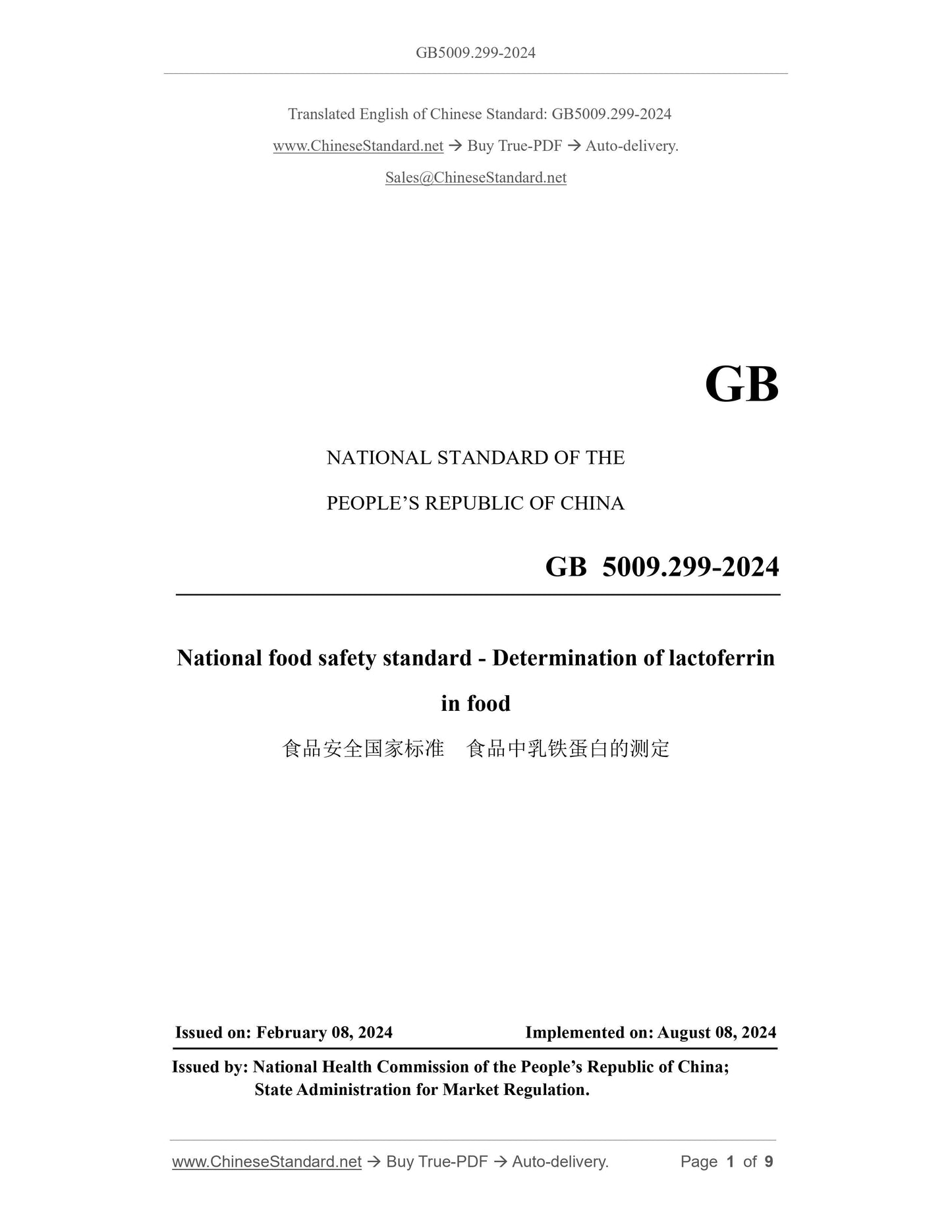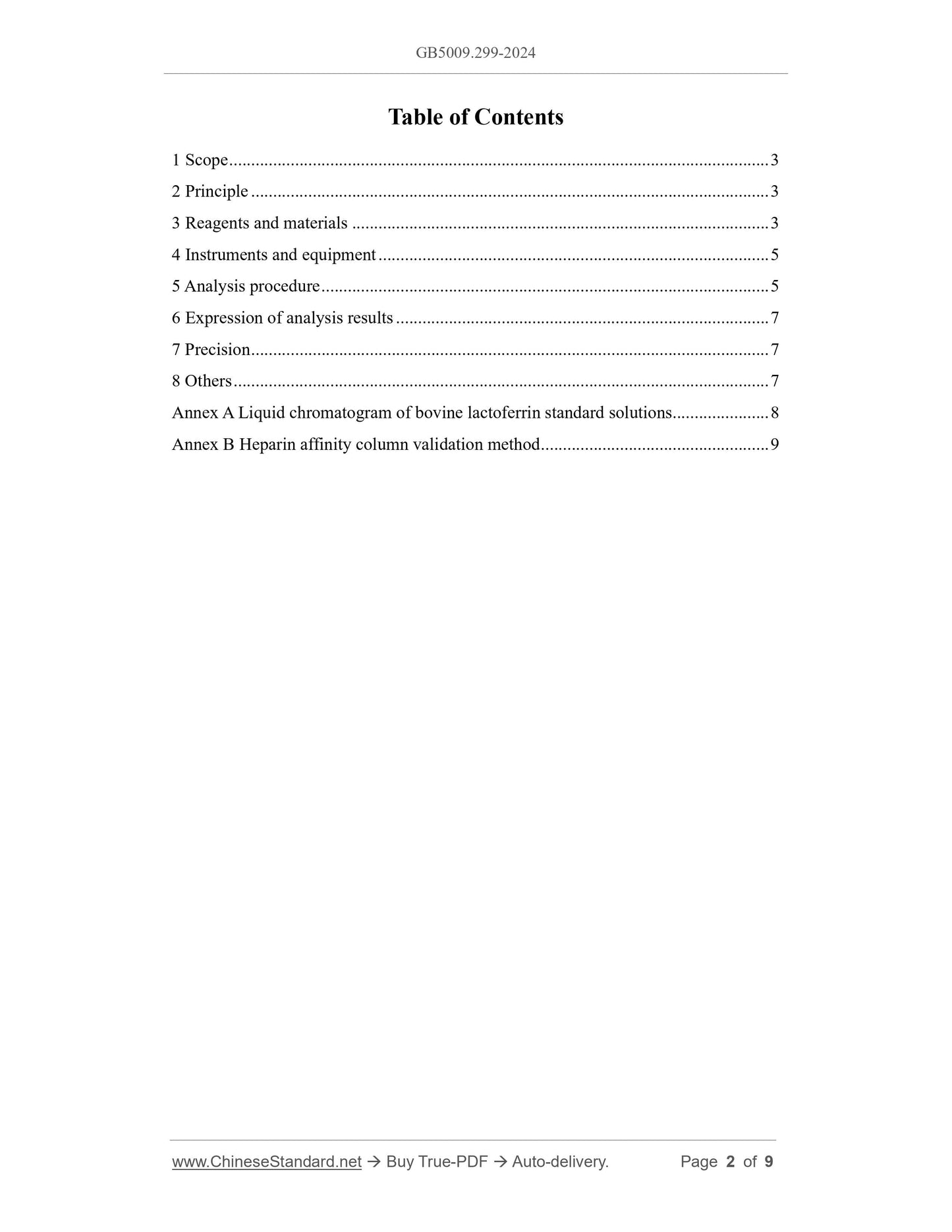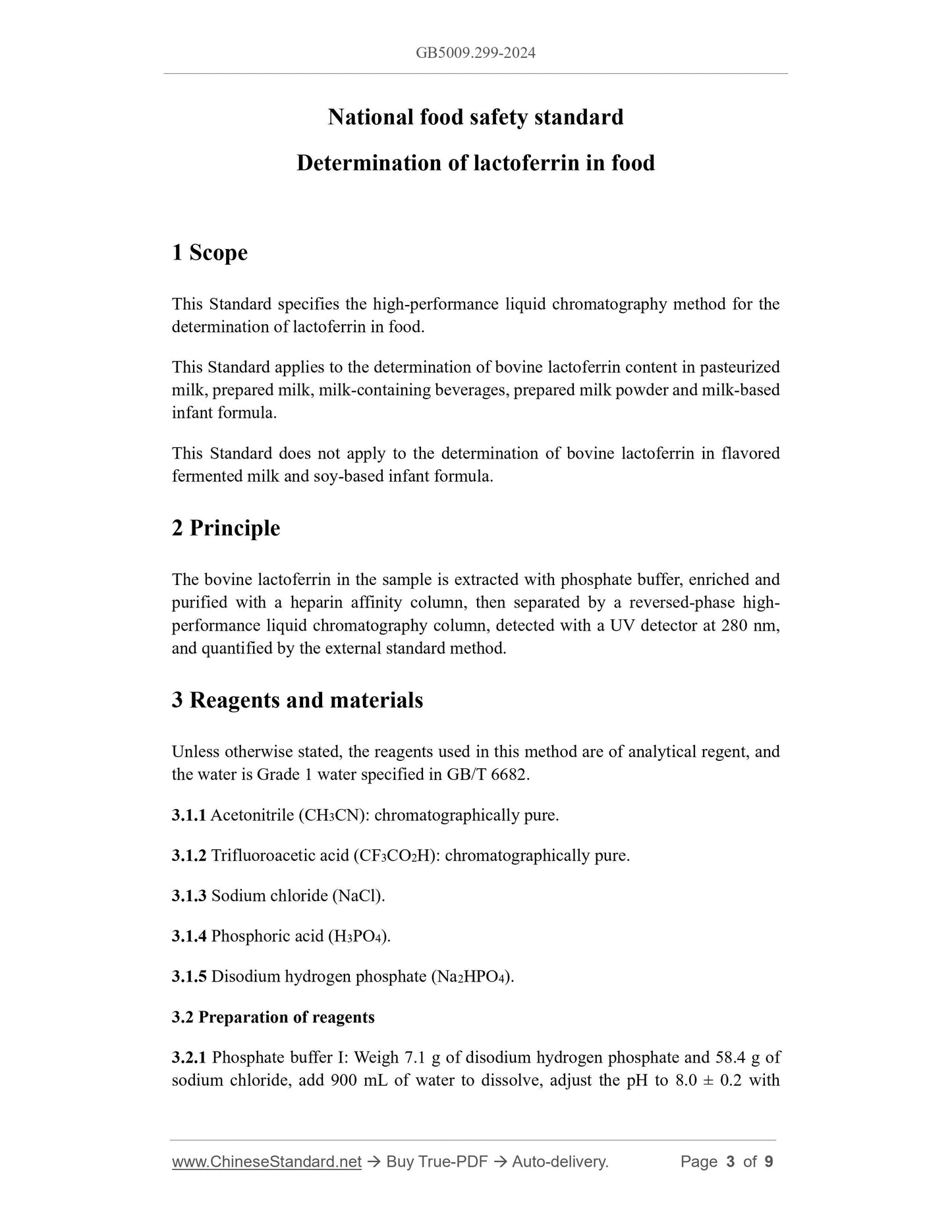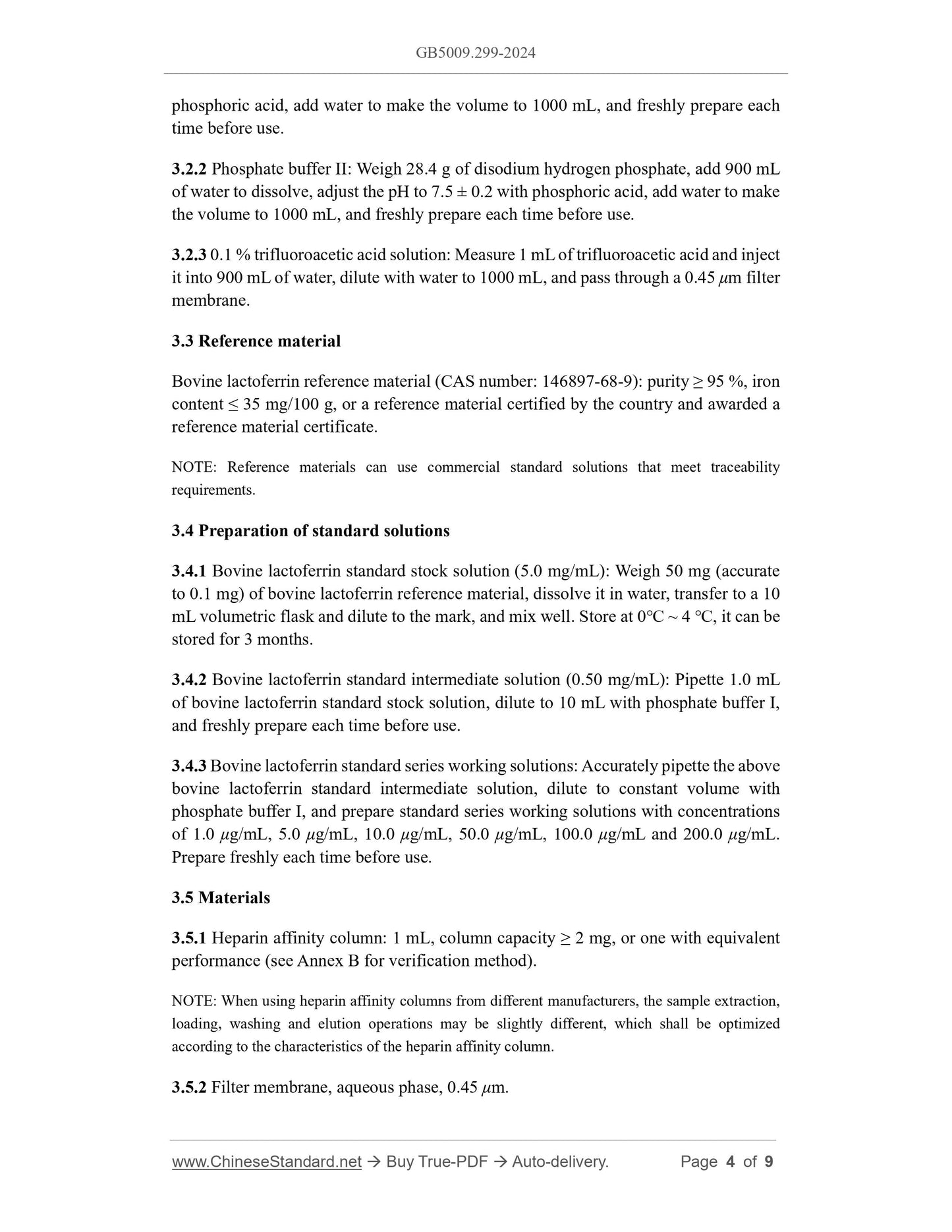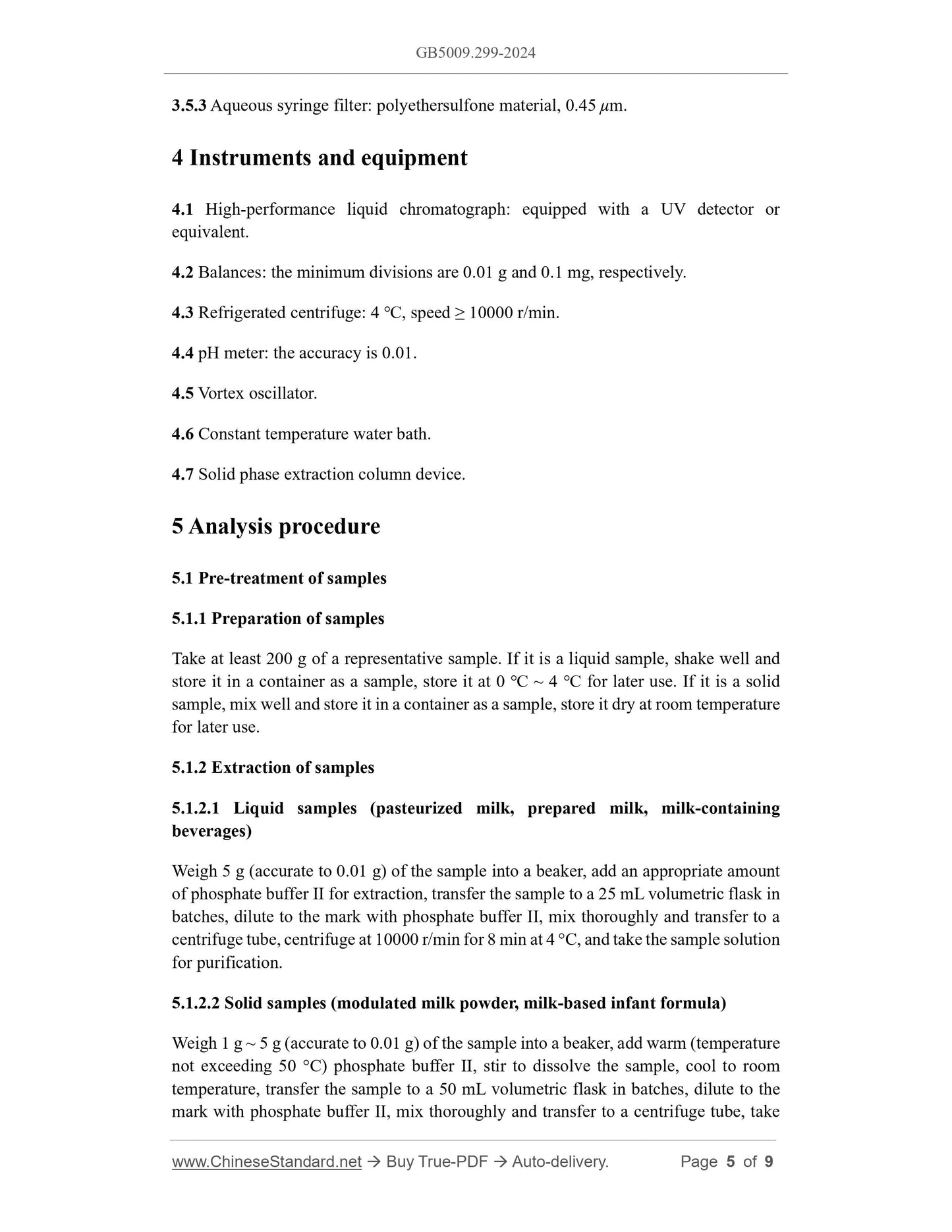PayPal, credit cards. Download editable-PDF and invoice in 1 second!
GB 5009.299-2024 English PDF (GB5009.299-2024)
GB 5009.299-2024 English PDF (GB5009.299-2024)
Precio habitual
$125.00 USD
Precio habitual
Precio de oferta
$125.00 USD
Precio unitario
/
por
Los gastos de envío se calculan en la pantalla de pago.
No se pudo cargar la disponibilidad de retiro
Delivery: 3 seconds. Download true-PDF + Invoice.
Get QUOTATION in 1-minute: Click GB 5009.299-2024
Historical versions: GB 5009.299-2024
Preview True-PDF (Reload/Scroll if blank)
GB 5009.299-2024: National food safety standards--Determination of lactoferrin in food
GB 5009.299-2024
GB
NATIONAL STANDARD OF THE
PEOPLE’S REPUBLIC OF CHINA
GB 5009.299-2024
National food safety standard - Determination of lactoferrin
in food
ISSUED ON: FEBRUARY 08, 2024
IMPLEMENTED ON: AUGUST 08, 2024
Issued by: National Health Commission of the People’s Republic of China;
State Administration for Market Regulation.
Table of Contents
1 Scope ... 3
2 Principle ... 3
3 Reagents and materials ... 3
4 Instruments and equipment ... 5
5 Analysis procedure ... 5
6 Expression of analysis results ... 7
7 Precision ... 7
8 Others ... 7
Annex A Liquid chromatogram of bovine lactoferrin standard solutions ... 8
Annex B Heparin affinity column validation method ... 9
National food safety standard
Determination of lactoferrin in food
1 Scope
This Standard specifies the high-performance liquid chromatography method for the
determination of lactoferrin in food.
This Standard applies to the determination of bovine lactoferrin content in pasteurized
milk, prepared milk, milk-containing beverages, prepared milk powder and milk-based
infant formula.
This Standard does not apply to the determination of bovine lactoferrin in flavored
fermented milk and soy-based infant formula.
2 Principle
The bovine lactoferrin in the sample is extracted with phosphate buffer, enriched and
purified with a heparin affinity column, then separated by a reversed-phase high-
performance liquid chromatography column, detected with a UV detector at 280 nm,
and quantified by the external standard method.
3 Reagents and materials
Unless otherwise stated, the reagents used in this method are of analytical regent, and
the water is Grade 1 water specified in GB/T 6682.
3.1.1 Acetonitrile (CH3CN): chromatographically pure.
3.1.2 Trifluoroacetic acid (CF3CO2H): chromatographically pure.
3.1.3 Sodium chloride (NaCl).
3.1.4 Phosphoric acid (H3PO4).
3.1.5 Disodium hydrogen phosphate (Na2HPO4).
3.2 Preparation of reagents
3.2.1 Phosphate buffer I: Weigh 7.1 g of disodium hydrogen phosphate and 58.4 g of
sodium chloride, add 900 mL of water to dissolve, adjust the pH to 8.0 ± 0.2 with
phosphoric acid, add water to make the volume to 1000 mL, and freshly prepare each
time before use.
3.2.2 Phosphate buffer II: Weigh 28.4 g of disodium hydrogen phosphate, add 900 mL
of water to dissolve, adjust the pH to 7.5 ± 0.2 with phosphoric acid, add water to make
the volume to 1000 mL, and freshly prepare each time before use.
3.2.3 0.1 % trifluoroacetic acid solution: Measure 1 mL of trifluoroacetic acid and inject
it into 900 mL of water, dilute with water to 1000 mL, and pass through a 0.45 μm filter
membrane.
3.3 Reference material
Bovine lactoferrin reference material (CAS number: 146897-68-9): purity ≥ 95 %, iron
content ≤ 35 mg/100 g, or a reference material certified by the country and awarded a
reference material certificate.
NOTE: Reference materials can use commercial standard solutions that meet traceability
requirements.
3.4 Preparation of standard solutions
3.4.1 Bovine lactoferrin standard stock solution (5.0 mg/mL): Weigh 50 mg (accurate
to 0.1 mg) of bovine lactoferrin reference material, dissolve it in water, transfer to a 10
mL volumetric flask and dilute to the mark, and mix well. Store at 0℃ ~ 4 ℃, it can be
stored for 3 months.
3.4.2 Bovine lactoferrin standard intermediate solution (0.50 mg/mL): Pipette 1.0 mL
of bovine lactoferrin standard stock solution, dilute to 10 mL with phosphate buffer I,
and freshly prepare each time before use.
3.4.3 Bovine lactoferrin standard series working solutions: Accurately pipette the above
bovine lactoferrin standard intermediate solution, dilute to constant volume with
phosphate buffer I, and prepare standard series working solutions with concentrations
of 1.0 μg/mL, 5.0 μg/mL, 10.0 μg/mL, 50.0 μg/mL, 100.0 μg/mL and 200.0 μg/mL.
Prepare freshly each time before use.
3.5 Materials
3.5.1 Heparin affinity column: 1 mL, column capacity ≥ 2 mg, or one with equivalent
performance (see Annex B for verification method).
NOTE: When using heparin affinity columns from different manufacturers, the sample extraction,
loading, washing and elution operations may be slightly different, which shall be optimized
according to the characteristics of the heparin affinity column.
3.5.2 Filter membrane, aqueous phase, 0.45 μm.
3.5.3 Aqueous syringe filter: polyethersulfone material, 0.45 μm.
4 Instruments and equipment
4.1 High-performance liquid chromatograph: equipped with a UV detector or
equivalent.
4.2 Balances: the minimum divisions are 0.01 g and 0.1 mg, respectively.
4.3 Refrigerated centrifuge: 4 ℃, speed ≥ 10000 r/min.
4.4 pH meter: the accuracy is 0.01.
4.5 Vortex oscillator.
4.6 Constant temperature water bath.
4.7 Solid phase extraction column device.
5 Analysis procedure
5.1 Pre-treatment of samples
5.1.1 Preparation of samples
Take at least 200 g of a representative sample. If it is a liquid sample, shake well and
store it in a container as a sample, store it at 0 ℃ ~ 4 ℃ for later use. If it is a solid
sample, mix well and store it in a container as a sample, store it dry at room temperature
for later use.
5.1.2 Extraction of samples
5.1.2.1 Liquid samples (pasteurized milk, prepared milk, milk-containing
beverages)
Weigh 5 g (accurate to 0.01 g) of the sample into a beaker, add an appropriate amount
of phosphate buffer II for extraction, transfer the sample to a 25 mL volumetric flask in
batches, dilute to the mark with phosphate buffer II, mix thoroughly and transfer to a
centrifuge tube, centrifuge at 10000 r/min for 8 min at 4 °C, and take the sample solution
for purification.
5.1.2.2 Solid samples (modulated milk powder, milk-based infant formula)
Weigh 1 g ~ 5 g (accurate to 0.01 g) of the sample into a beaker, add warm (temperature
not exceeding 50 °C) phosphate buffer II, stir to dissolve the sample, cool to room
temperature, transfer the sample to a 50 mL volumetric flask in batches, dilute to the
mark with phosphate buffer II, mix thoroughly and transfer to a centrifuge tube, take
Get QUOTATION in 1-minute: Click GB 5009.299-2024
Historical versions: GB 5009.299-2024
Preview True-PDF (Reload/Scroll if blank)
GB 5009.299-2024: National food safety standards--Determination of lactoferrin in food
GB 5009.299-2024
GB
NATIONAL STANDARD OF THE
PEOPLE’S REPUBLIC OF CHINA
GB 5009.299-2024
National food safety standard - Determination of lactoferrin
in food
ISSUED ON: FEBRUARY 08, 2024
IMPLEMENTED ON: AUGUST 08, 2024
Issued by: National Health Commission of the People’s Republic of China;
State Administration for Market Regulation.
Table of Contents
1 Scope ... 3
2 Principle ... 3
3 Reagents and materials ... 3
4 Instruments and equipment ... 5
5 Analysis procedure ... 5
6 Expression of analysis results ... 7
7 Precision ... 7
8 Others ... 7
Annex A Liquid chromatogram of bovine lactoferrin standard solutions ... 8
Annex B Heparin affinity column validation method ... 9
National food safety standard
Determination of lactoferrin in food
1 Scope
This Standard specifies the high-performance liquid chromatography method for the
determination of lactoferrin in food.
This Standard applies to the determination of bovine lactoferrin content in pasteurized
milk, prepared milk, milk-containing beverages, prepared milk powder and milk-based
infant formula.
This Standard does not apply to the determination of bovine lactoferrin in flavored
fermented milk and soy-based infant formula.
2 Principle
The bovine lactoferrin in the sample is extracted with phosphate buffer, enriched and
purified with a heparin affinity column, then separated by a reversed-phase high-
performance liquid chromatography column, detected with a UV detector at 280 nm,
and quantified by the external standard method.
3 Reagents and materials
Unless otherwise stated, the reagents used in this method are of analytical regent, and
the water is Grade 1 water specified in GB/T 6682.
3.1.1 Acetonitrile (CH3CN): chromatographically pure.
3.1.2 Trifluoroacetic acid (CF3CO2H): chromatographically pure.
3.1.3 Sodium chloride (NaCl).
3.1.4 Phosphoric acid (H3PO4).
3.1.5 Disodium hydrogen phosphate (Na2HPO4).
3.2 Preparation of reagents
3.2.1 Phosphate buffer I: Weigh 7.1 g of disodium hydrogen phosphate and 58.4 g of
sodium chloride, add 900 mL of water to dissolve, adjust the pH to 8.0 ± 0.2 with
phosphoric acid, add water to make the volume to 1000 mL, and freshly prepare each
time before use.
3.2.2 Phosphate buffer II: Weigh 28.4 g of disodium hydrogen phosphate, add 900 mL
of water to dissolve, adjust the pH to 7.5 ± 0.2 with phosphoric acid, add water to make
the volume to 1000 mL, and freshly prepare each time before use.
3.2.3 0.1 % trifluoroacetic acid solution: Measure 1 mL of trifluoroacetic acid and inject
it into 900 mL of water, dilute with water to 1000 mL, and pass through a 0.45 μm filter
membrane.
3.3 Reference material
Bovine lactoferrin reference material (CAS number: 146897-68-9): purity ≥ 95 %, iron
content ≤ 35 mg/100 g, or a reference material certified by the country and awarded a
reference material certificate.
NOTE: Reference materials can use commercial standard solutions that meet traceability
requirements.
3.4 Preparation of standard solutions
3.4.1 Bovine lactoferrin standard stock solution (5.0 mg/mL): Weigh 50 mg (accurate
to 0.1 mg) of bovine lactoferrin reference material, dissolve it in water, transfer to a 10
mL volumetric flask and dilute to the mark, and mix well. Store at 0℃ ~ 4 ℃, it can be
stored for 3 months.
3.4.2 Bovine lactoferrin standard intermediate solution (0.50 mg/mL): Pipette 1.0 mL
of bovine lactoferrin standard stock solution, dilute to 10 mL with phosphate buffer I,
and freshly prepare each time before use.
3.4.3 Bovine lactoferrin standard series working solutions: Accurately pipette the above
bovine lactoferrin standard intermediate solution, dilute to constant volume with
phosphate buffer I, and prepare standard series working solutions with concentrations
of 1.0 μg/mL, 5.0 μg/mL, 10.0 μg/mL, 50.0 μg/mL, 100.0 μg/mL and 200.0 μg/mL.
Prepare freshly each time before use.
3.5 Materials
3.5.1 Heparin affinity column: 1 mL, column capacity ≥ 2 mg, or one with equivalent
performance (see Annex B for verification method).
NOTE: When using heparin affinity columns from different manufacturers, the sample extraction,
loading, washing and elution operations may be slightly different, which shall be optimized
according to the characteristics of the heparin affinity column.
3.5.2 Filter membrane, aqueous phase, 0.45 μm.
3.5.3 Aqueous syringe filter: polyethersulfone material, 0.45 μm.
4 Instruments and equipment
4.1 High-performance liquid chromatograph: equipped with a UV detector or
equivalent.
4.2 Balances: the minimum divisions are 0.01 g and 0.1 mg, respectively.
4.3 Refrigerated centrifuge: 4 ℃, speed ≥ 10000 r/min.
4.4 pH meter: the accuracy is 0.01.
4.5 Vortex oscillator.
4.6 Constant temperature water bath.
4.7 Solid phase extraction column device.
5 Analysis procedure
5.1 Pre-treatment of samples
5.1.1 Preparation of samples
Take at least 200 g of a representative sample. If it is a liquid sample, shake well and
store it in a container as a sample, store it at 0 ℃ ~ 4 ℃ for later use. If it is a solid
sample, mix well and store it in a container as a sample, store it dry at room temperature
for later use.
5.1.2 Extraction of samples
5.1.2.1 Liquid samples (pasteurized milk, prepared milk, milk-containing
beverages)
Weigh 5 g (accurate to 0.01 g) of the sample into a beaker, add an appropriate amount
of phosphate buffer II for extraction, transfer the sample to a 25 mL volumetric flask in
batches, dilute to the mark with phosphate buffer II, mix thoroughly and transfer to a
centrifuge tube, centrifuge at 10000 r/min for 8 min at 4 °C, and take the sample solution
for purification.
5.1.2.2 Solid samples (modulated milk powder, milk-based infant formula)
Weigh 1 g ~ 5 g (accurate to 0.01 g) of the sample into a beaker, add warm (temperature
not exceeding 50 °C) phosphate buffer II, stir to dissolve the sample, cool to room
temperature, transfer the sample to a 50 mL volumetric flask in batches, dilute to the
mark with phosphate buffer II, mix thoroughly and transfer to a centrifuge tube, take
Share
